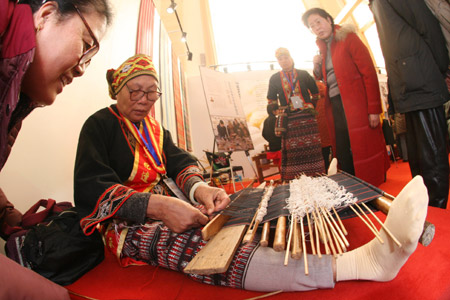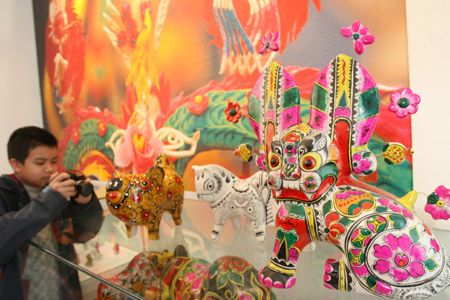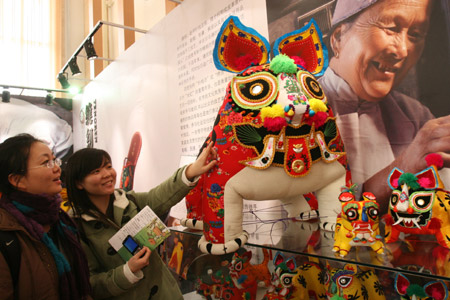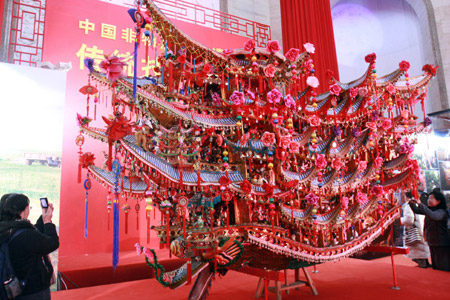Beijing Hosts Intangible Heritage Exhibition

A woman of Li ethnic group from south China's Hainan Province showcases brocade-weaving skills at an exhibition, intending to showcase the country's progress in protecting intangible cultural items, in Beijing, capital of China, Feb. 10, 2009. Some 2,322 precious items and activities such as paper-cutting paintings, printing, pottery, carvings, tea brewing, embroidery and traditional medicine were showed on the exhibition. (Xinhua/Chen Xiaogen)
A massive collection of folk arts and craftsmanship has come alive in Beijing in a huge exhibition of China's intangible heritage. The practitioners of various arts are in the Chinese capital to demonstrate the techniques of creating their art. The exhibition opened at Beijing's Agricultural Exhibition Hall on Monday as China celebrated the Lantern Festival.
This is the first time for Macao's religious Figure Carving to be demonstrated in Beijing. The woodwork technique was added to the national intangible cultural heritage list in June last year.
Tsang Tak Hang, a craftsman from Macao said, "I'm glad to have brought Macao's special craft to Beijing. I never expected to see so many elite craftsmanship come together in one single exhibition. The religious figure carving has preserved and followed a beautiful woodcarving tradition in China up to the present day. It is an intangible cultural heritage that truly deserves our special attention and protection."
Being the largest of its kind in the country, the exhibition gathers examples of China's most exquisite traditional techniques and artworks. The show involved activities such as paper-cut, printing, pottery, carving and embroidery.

A Chinese boy takes photos for exhibits at an exhibition intending to showcase the country's progress in protecting intangible cultural items in Beijing, capital of China, Feb. 10, 2009. (Xinhua/Chen Xiaogen)
The exhibition includes 133 items of folk arts and crafts on the state- and province-level intangible heritage lists. Fourteen state-level masters and 130 representative heirs to those arts and crafts, including those from different ethnic minorities were invited to give live performances.
China initiated the Intangible Cultural Heritage protection project in 2005. The list has been updated twice and now includes more than a thousand items.
Organizers say the event is intended to showcase the progress in protecting intangible cultural items.
Zhou Heping, the vice minister of culture said, "The exhibition is intended to showcase the varied and profound traditional Chinese culture and raise public awareness of cultural heritage protection."

Two Chinese girls view exhibits at an exhibition intending to showcase the country's progress in protecting intangible cultural items in Beijing, capital of China, Feb. 10, 2009. (Xinhua/Chen Xiaogen)
One of the highlights is traditional Chinese herbal medicine. Organizers have set up a special section to showcase the ancient Chinese medicine god-- Shennong, as well as the ancient drug jars, prescriptions and seals from old drugstores.
Bai Yang, the curator of traditional Chinese medicine museum, said, "I hope visitors will get some idea of just how advanced and splendid our country's medical science is when they see the exhibits here. Traditional Chinese medicine is now enhancing its influence around the globe. This exhibit will allow visitors to sample the rich culture behind the ancient trade."
Admission to the intangible cultural heritage exhibition is free. It will run at the National Agricultural Exhibition Hall until February 23rd.

A Chinese takes pictures for a dragon-boat-shaped lamp from east China's Zhejiang Province at an exhibition intending to showcase the country's progress in protecting intangible cultural items in Beijing, capital of China, Feb. 10, 2009.
(Source: CCTV.com)
 Print
Print